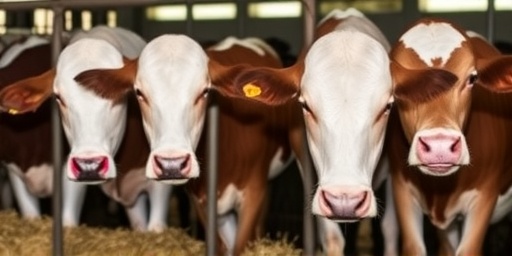SAN FRANCISCO, CA – In a startling development for U.S. agriculture and public health, health officials have confirmed the presence of highly pathogenic H5N1 Bird flu in dairy cows across California, marking the state’s first such outbreak in cattle. Compounding concerns, a mild human case of Bird flu has been detected in a farm worker near the affected herds, representing the latest in a series of human infections tied to animal reservoirs.
The California Department of Food and Agriculture (CDFA) announced the detections on Friday, prompting immediate quarantines, enhanced testing protocols, and the culling of infected dairy cows to prevent wider spread. This incident follows a surge in H5N1 cases among wild birds and poultry nationwide, with dairy cows now emerging as a novel vector in the ongoing Bird flu crisis.
Officials emphasize that the risk to the general public remains low, but the jump to humans underscores the need for vigilance among farm workers handling livestock.
Detection Traced to Central Valley Dairy Farms
The outbreak was first identified in Fresno County, a hub for California’s massive dairy industry, which produces nearly 20% of the nation’s milk supply. Routine surveillance detected H5N1 in milk samples from several herds last week, with genetic sequencing confirming the virus matches strains circulating in wild birds.
“We identified clinical signs of illness in dairy cows, including reduced milk production and respiratory symptoms, which led to confirmatory testing,” stated Dr. Annette Jones, CDFA State Veterinarian, in a press briefing. “This is the first confirmed H5N1 avian influenza case in California dairy cows, but rapid response is key to containment.”
According to the CDFA, four dairies in Fresno and Kern Counties have reported affected animals, with approximately 150 cows showing symptoms. Federal partners from the USDA and CDC have mobilized to assist, deploying mobile labs for on-site testing. Preliminary data indicates a mortality rate of about 10% in infected herds, though most cases are mild.
- Affected Herds: 4 dairies confirmed, 2 under quarantine
- Symptoms in Cows: Fever, cough, nasal discharge, drop in milk yield
- Virus Strain: H5N1 clade 2.3.4.4b, same as in recent U.S. poultry outbreaks
California’s dairy sector, valued at over $7 billion annually, now faces scrutiny as experts probe how the virus spilled over from birds to mammals. Researchers suspect contaminated feed or water sources exposed to infected wild waterfowl.
First Human Case Linked to Infected Dairy Cows
In a nearby development, the CDC confirmed a human case of bird flu (H5N1) in a dairy farm worker who handled milk from an affected herd. The individual, a 42-year-old man from Tulare County, experienced mild conjunctivitis and flu-like symptoms but has fully recovered after antiviral treatment with oseltamivir.
“This human case is directly associated with exposure to sick dairy cows, highlighting the occupational risk for farm workers,” said Dr. Nirav Shah, CDC Director. “No person-to-person transmission has been detected, and pasteurization kills the virus in milk, so commercial dairy products remain safe.”
This marks the second human H5N1 case in the U.S. this year linked to dairy cows, following a Michigan case in May. Globally, H5N1 has caused over 880 human infections since 2003, with a 52% fatality rate, though U.S. cases have been mild. The patient’s close contact with raw milk and manure is believed to be the transmission route.
Health officials have tested 25 close contacts, all negative so far. The human virus genome shows no mutations suggesting enhanced transmissibility, providing some reassurance.
Officials Deploy Aggressive Culling and Surveillance Measures
In response, California Governor Gavin Newsom activated emergency protocols, authorizing the humane depopulation of infected and exposed dairy cows. Over 100 animals have been culled, with compensation offered to farmers through USDA indemnity programs.
“We’re moving swiftly to protect our herds, workers, and food supply,” Newsom said via statement. “Enhanced biosecurity and surveillance will be mandatory for all dairies statewide.”
New measures include:
- Daily health checks and milk testing for all dairy operations
- Restrictions on cattle movement from affected zones
- Personal protective equipment (PPE) mandates for workers, including goggles and masks
- Wildlife monitoring near farms to track bird reservoirs
- Public reporting hotlines for suspicious livestock symptoms
The USDA has elevated its response to Incident Level 3, coordinating with states where H5N1 has hit 34 dairy herds across nine states since March. Nationally, over 1,000 wild birds and 100 million poultry have succumbed to the virus this year.
Dairy Industry Braces for Economic Fallout and Supply Disruptions
California’s dairy cows produce 40 billion pounds of milk yearly, feeding into national and export markets. While no commercial milk recalls have occurred—thanks to pasteurization’s effectiveness—the outbreak could dent consumer confidence and hike prices.
“Farmers are on high alert; this could mean lost revenue and repopulation challenges,” noted Peter Van Rombeau, CEO of the California Dairy Association. “Biosecurity upgrades cost thousands per farm, but we’re committed to transparency.”
Raw milk advocates face added pressure, as unpasteurized products from infected herds pose higher risks. The FDA reiterated that all pasteurized milk tests negative for live virus, but some organic dairies report voluntary testing spikes.
Economic models from Iowa State University estimate a national H5N1 dairy outbreak could cost $1-2 billion, factoring in culling, lost production, and trade barriers. California’s export-dependent industry eyes potential bans from partners like Mexico and Canada.
Experts Assess Broader Public Health Risks and Future Preparedness
Virologists warn that H5N1’s mammalian adaptation—seen in cows, cats, and sea lions—raises pandemic potential if it evolves for human-to-human spread. “Dairy cows act as a mixing vessel for viral mutations,” explained Dr. Angela Rasmussen, virologist at University of Saskatchewan. “Surveillance in milk is a smart early-warning system.”
The CDC is expanding its candidate vaccine virus library, with trials underway for farm workers. Antiviral stockpiles are ample, and wastewater monitoring detects H5N1 fragments in some California sewers, likely from animal waste.
Internationally, the WHO reports 61 human cases in 2024, mostly mild, but urges global dairy surveillance. U.S. experts call for $100 million in funding for livestock vaccines, stalled in Congress.
Looking ahead, officials plan genomic surveillance dashboards and farm audits. Consumers are advised to cook meat thoroughly, avoid raw milk, and report sick birds. As fall migration looms, bringing more wild carriers, California’s battle against bird flu tests the resilience of its agricultural powerhouse.
Updates will follow as testing expands, with inter-agency briefings scheduled weekly.









